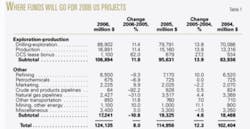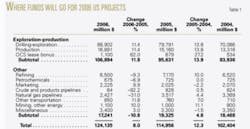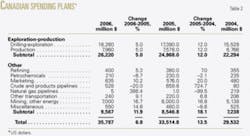Worldwide oil and gas industry capital expenditures will increase sharply this year, especially for upstream work.
High oil and gas prices are supporting the investment needed to boost worldwide production capacity. In the US and outside North America, upstream spending will grow more than 10% this year.
Less money will be invested in downstream operations in the US than during 2005, though, as pipeline construction and refinery upgrades decline.
OGJ estimates that in Canada spending will increase mostly on the strength of oil sands investments.
Outside the US and Canada, construction of LNG facilities and petrochemical complexes will boost investment already lifted by exploration and production. E&P spending in developing countries and high-risk areas will grow this year, according to spending plans of many of the largest US-based oil and gas firms.
The findings in this report are taken from Oil & Gas Journal’s annual capital spending survey of oil and gas companies based in the US and Canada. All figures are in US dollars.
Oil, gas market
With oil and gas prices expected to remain elevated this year, the estimates in this outlook could prove conservative.
Several forces-geopolitical more than fundamental-are supporting oil prices. Among these forces is the threat of supply disruptions in a few major oil exporting countries, including Nigeria.
And extremely limited spare production capacity and growing worldwide demand exacerbate the market edginess that is propping up prices, in spite of plentiful inventories.
In the US, rising gas demand is increasing the need for additional LNG receiving capacity. In the long term, domestic production looks unable to supply growing demand for gas-fired power generation.
The US and Canadian companies set their 2006 capital budgets in light of oil and gas prices that show few signs of losing much strength this year. Last year’s average US wellhead oil price was $50.26/bbl and the average wellhead gas price, $7.51/MMcf. Each of these averages is up about 37% from a year earlier.
US upstream spending
Upstream oil and gas spending in the US will increase 12% this year. OGJ forecasts that US exploration, drilling, and production outlays will total more than $105 billion.
This estimate is primarily based on OGJ’s projection of 2006 drilling activity (OGJ, Jan. 16, 2006, p. 16). Exploration and drilling spending will increase to $88.9 billion from $79.8 billion last year and $70 billion a year earlier.
Of this year’s E&D capital spending in the US, geological and geophysical costs will account for $11.6 billion.
Spending on production will grow at the same pace as E&D outlays and will total $16.9 billion, up from $15.2 billion last year.
In additional spending, OGJ estimates that bonus payments related to Outer Continental Shelf lease sales will total $1.1 billion.
The US Minerals Management Service plans to hold three lease sales this year. The first one, Sale 198 held last month, garnered more than $588 million in high bids for oil and gas leases in the central Gulf of Mexico (OGJ, Mar. 20, 2006, p. 29). The next scheduled sales will feature leases in the western Gulf of Mexico and Alaska’s Cook Inlet.
Some US firms are planning to shift some of their 2006 upstream capital spending toward the US from other areas.
Pioneer Natural Resources Inc., Dallas, which has budgeted $1.3 billion for capital spending this year, plans to reduce exploration spending in higher-risk areas to 10% of the capital spending budget this year from 30% last year.
Pioneer said that over 80% of its 2006 capital budget is directed toward onshore low-risk North American activities ranging from development drilling in core areas to coalbed methane wells.
Anadarko Petroleum Corp. announced that 74% of its 2006 capital budget is planned for the US, including both onshore and in the deep water of the Gulf of Mexico. The company plans to focus much of this on unconventional tight gas plays in Texas and Louisiana.
Other US expenditures
Refining expenditures, although declining, will dominate US downstream capital budgets this year. OGJ expects that such spending will be $6.5 billion, down more than 9% from a year ago.
Capital spending for LNG receiving terminals in the US is up. Cheniere Energy Inc. said its terminal and pipelines groups plan to spend about $3 billion over 5 years to bring online three LNG receiving terminals and associated pipelines in Texas and Louisiana.
Total US pipeline spending this year will decline, though, as the number of miles of planned construction is down.
Plans call for a total of 1,418 miles of natural gas lines to be built in the US this year, mostly larger than 30 in. in diameter (OGJ, Feb. 13, 2006, p. 57). The cost of these projects is $2.4 billion. OGJ estimates the cost of last year’s gas line construction in the US at $3.5 billion.
Plans also call for the construction of 182 miles of crude and products pipelines this year in the US. Spending for these projects will total $64 million, as all are planned to be smaller than 20 in. in diameter.
Capital outlays in the US petrochemical industry, which were unchanged in 2005, will decline this year. OGJ expects spending at petrochemical plants to be $675 million, down 7%, as rising feedstock costs shift production of petrochemicals to the Middle East.
Marketing capital expenditures, which include gasoline stations and convenience stores, will rebound about 10% this year. Last year, these expenses declined 2% to $2.025 billion.
Refining
In 2006, refining expenditures in the US and Canada will shift toward value-adding conversion projects and away from projects to meet government regulations.
North American refiners have made substantial expenditures toward meeting the June 1 deadline for new product specifications for ultralow-sulfur diesel fuel. Terminals must meet the new standards by Sept. 1.
Marathon Oil Corp. plans to spend $886 million this year on refining, marketing, and transportation. Among these segments only refining capital outlays will decline, to $467 million from $511 million last year.
Marathon said that it plans to target value-added projects mostly aimed at debottlenecking refinery units to increase throughput capacity. Included in its budget is spending for the front-end engineering and design work for the 180,000 b/d Garyville, La., refinery expansion project.
Still, Marathon said it will invest $200 million this year to meet revised EPA air quality standards, best achievable control technology, and Tier II clean fuels regulations. The company also plans to increase its ethanol-related investments this year.
Spending in Canada
Oil and gas industry capital expenditures in Canada will total $35.8 billion this year, up 7%.
Exploration, drilling, and production outlays will account for $26.2 billion of the total. The rest of the spending is allocated to all other industry activity, including oil sands development and pipeline construction.
In 2004, there were 19,652 well completions in Canada, according to the Canadian Association of Petroleum Producers (CAPP). Of these, 77% were gas wells.
OGJ estimates that last year, total completions in Canada increased to 22,004 and that this year they will move up to 22,775.
Drilling and exploration capital expenditures will be $18.26 billion, up 5%. And production outlays will grow at the same pace to total nearly $8 billion.
The mining and other energy category includes oil sands mining expenditures. CAPP statistics indicate that 2 years ago, oil sands development expenditures in Canada were over $5 billion.
With a rise in the production and upgrading of oil sands, expenditures will continue to increase. OGJ expects capital expenditures for mining and other energy sources in Canada this year to total $7 billion, up from $6 billion last year.
Refining expenditures will continue to increase this year, too, although less money will go toward clean air regulations for fuels than last year. OGJ forecasts that capital outlays at Canadian refineries will increase to $400 million from $380 million last year.
Petro-Canada, Calgary, has budgeted $265 million in 2006 to meet regulations to produce clean-burning diesel fuel, down from $630 million last year.
However, Petro-Canada’s total refinery expenditures for this year are budgeted at $840 million, down just 8%, as spending shifts toward growth. The company this year plans a conversion of its Edmonton refinery, expansion of its lubricants plant, and a feasibility study for its Montreal coker.
Pipeline expenditures in Canada will decline slightly this year, as less construction is planned for 2006 than was carried out last year. Crude and products lines will dominate, as they did in 2005.
OGJ forecasts that capital spending this year in Canada for crude and products pipelines will be $528 million, down from $660 million last year. Meanwhile, spending for natural gas lines in Canada will be $5 million, up from less than $1 million last year.
Petrochemical plant outlays will continue to decline, down to $210 million from $230 million last year and $235 million in 2004.
In 2005, total capital outlays in Canada increased almost 14%, with a 12% surge in upstream spending. Downstream, the biggest increase in spending was for crude and product pipelines.
Spending elsewhere
Total capital expenditures outside Canada and the US will surge in 2006.
The most recent Lehman Bros. E&P spending survey indicates a 15% increase in worldwide spending this year (OGJ, Dec. 19, 2005, p. 5). Outside North America, the survey of 85 companies revealed, exploration and production spending in 2006 is forecast to increase to $156 billion.
OGJ finds that, as usual, major oil and gas producers will lead US firms in capital spending outside North America, with upstream and downstream projects planned.
Marathon plans to boost its 2006 worldwide exploration and exploitation budget to $588 million, an increase of $199 million over 2005 spending. The company’s exploration budget is $80 million higher than last year’s, largely reflecting increased activity in Angola.
In addition, Marathon has budgeted $341 million for worldwide integrated gas projects this year. This includes money allocated for the Equatorial Guinea LNG Train 1 project, which is on schedule to begin shipments in the third quarter of 2007. Marathon holds and funds a 60% interest in this project.
ConocoPhillips has allotted about $1.7 billion of its capital budget to refining and marketing outside the US. However, most of this will fund the company’s acquisition of the Wilhelmshaven refinery in Germany, including the initial expenditures toward a deep-conversion project and other capital improvements.
Russia and the Caspian region will receive about $700 million of Conoco- Phillips’s E&P budget in 2006, with the majority of the funds supporting the continued development of Kashagan field and the company’s Timan-Pechora oil and gas development joint venture with Lukoil.
Occidental Petroleum Corp. in February announced that its base production outlook for 2010 of at least 700,000 boe/d was based on projects already in hand and did not depend on new exploration success, new enhanced oil recovery projects, or new acquisitions.
Instead, growth will come from Occidental’s Argentina assets recently acquired from Vintage Petroleum Inc.; the giant Dolphin gas project in Qatar and the United Arab Emirates; the Mukhaizna EOR project in Oman; and Libya. Occidental said that last year it added reserves of 123 million boe, with 91 million boe in the Middle East.
Meanwhile, Amerada Hess Corp. plans to focus the majority of its 2006 capital budget outside the US. Of its $3.85 billion exploration and production capital expenditures, $620 million is allocated for European operations.
And $2.47 billion of the Amerada Hess budget is earmarked for all other locations outside the US, including Africa and Asia. Of this amount, $413 million will go toward the acquisition of Apache Corp.’s 55% interest in the deepwater section of Egypt’s West Mediterranean Concession, and $1.4 billion is planned for field developments in Algeria, Indonesia, Malaysia, Thailand, and offshore Equatorial Guinea.
About 75%, or $11.3 billion, of Chevron Corp.’s total 2006 capital and exploratory budget is targeted for upstream investment in exploration, production, and gas-related projects, and $8 billion is earmarked for projects outside the US.
Part of Chevron’s major development spending this year includes longer-term projects in Angola, Nigeria, Kazakhstan, and Australia, mostly involving oil and gas production and LNG facilities. ✦


